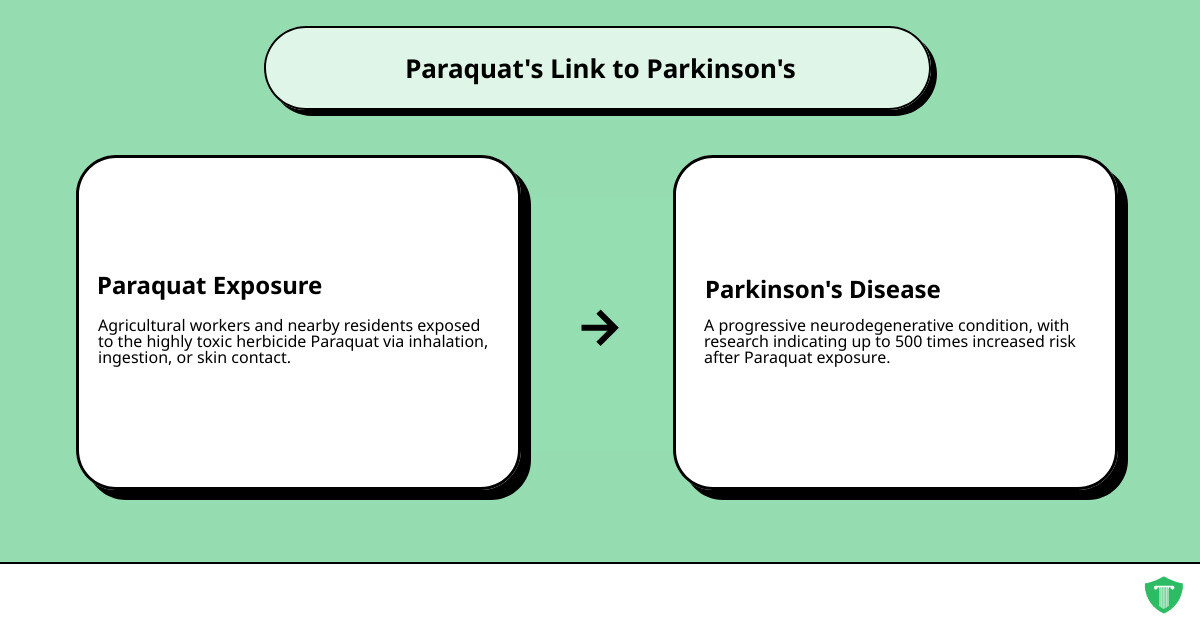


When Agricultural Workers Face a Hidden Enemy
If you or a loved one was diagnosed with Parkinson’s disease after being exposed to the herbicide Paraquat, you may be entitled to significant compensation. Here’s what you need to know:
Key Facts About Paraquat Lawsuits:
- Who Qualifies: Individuals diagnosed with Parkinson’s disease after paraquat exposure.
- Legal Grounds: Manufacturers like Syngenta and Chevron failed to warn about the known risks.
- Current Status: Nearly 6,000 cases are consolidated in a federal multidistrict litigation (MDL).
- First Trials: The first bellwether trials are scheduled for October 14, 2025.
- Cost to You: Nothing upfront. Attorneys work on a contingency fee, meaning they only get paid if you win.
- Time Limits: State laws limit your time to file, typically 2-3 years from diagnosis.
Paraquat is a highly toxic weed killer banned in over 70 countries but still used in the United States. Research, including studies compiled by The Michael J. Fox Foundation, shows a strong link between Paraquat exposure and Parkinson’s disease.
Thousands of farmers, agricultural workers, and residents living near treated farmland have filed lawsuits alleging that manufacturers knew about the Parkinson’s risk for decades but concealed it. With major trials approaching and some settlements already reached, now is a critical time to explore your legal options.
The Hidden Dangers of Paraquat: From Weed Killer to Health Crisis
Paraquat dichloride is a highly toxic herbicide used in the U.S. since the 1960s under brand names like Gramoxone, Firestorm, and Cyclone. The EPA classifies it as a “Restricted Use Product,” meaning only licensed applicators can handle it. A single sip can be fatal. Despite being banned in over 70 countries, including Switzerland where manufacturer Syngenta is based, it remains legal for use on American farms.
The chemical works by creating oxidative stress, a process that destroys plant cells. Unfortunately, this same mechanism attacks human cells, particularly the dopamine-producing neurons in the brain—the very cells destroyed by Parkinson’s disease. The link is so established that scientists use paraquat to induce Parkinson’s in lab animals for research.
The Undeniable Link to Parkinson’s Disease
Mounting scientific evidence confirms the connection between paraquat and Parkinson’s. Key studies show:
- Individuals exposed to paraquat may face a significantly higher risk of developing Parkinson’s disease.
- A 2009 study in the American Journal of Epidemiology found that living within 1,600 feet of paraquat-treated areas increased Parkinson’s risk by 75%.
- A 2011 study found that people who mixed or applied paraquat had a 2.5 times higher risk of developing the disease.
These statistics represent thousands of farmers, agricultural workers, and rural residents whose lives have been permanently altered. You can find more scientific research on Paraquat’s toxicity from the CDC.
Recognizing the Symptoms of Parkinson’s
If you were exposed to paraquat, it’s crucial to recognize the symptoms of Parkinson’s. The disease affects both motor (movement) and non-motor functions.
Common Motor Symptoms:
- Tremors, especially a “pill-rolling” motion in a hand at rest.
- Bradykinesia (slowed movement), making simple tasks difficult.
- Muscle stiffness and limited range of motion.
- Impaired balance, stooped posture, and increased risk of falls.
- Smaller handwriting and loss of automatic movements like swinging arms while walking.
- Softer, monotone, or slurred speech.
Common Non-Motor Symptoms:
- Sleep disorders like insomnia or restless legs.
- Cognitive changes, including memory or planning difficulties.
- Mood disorders such as depression and anxiety.
- Loss of smell, unexplained pain, or numbness.
- Autonomic issues like constipation or dizziness.
If you experience these symptoms, seek a medical evaluation immediately. The Mayo Clinic provides comprehensive information on Parkinson’s symptoms.
Who is Most at Risk of Paraquat Exposure?
Exposure risk is highest for certain occupations and individuals:
- Agricultural Workers: Farmers, farm laborers, and others who mix, load, or apply paraquat.
- Licensed Pesticide Applicators: Professionals who spray paraquat on farms, orchards, and rights-of-way.
- Residents Near Sprayed Farmland: People living near treated fields can be exposed through pesticide drift in the air or contaminated water.
- Landscapers and Groundskeepers: Those who may have used paraquat for commercial weed control.
Exposure can occur through inhalation, skin contact, or accidental ingestion. Manufacturers are accused of failing to warn these high-risk groups about the link to Parkinson’s disease for decades.
Building Your Case: Why You Need a Paraquat Lawsuit Attorney
Facing a Parkinson’s diagnosis is overwhelming. Taking on a major corporation adds another layer of stress. A paraquat lawsuit attorney specializes in these complex cases, which involve deep scientific evidence and powerful corporate defendants. You need an expert who understands the science of oxidative stress and the legal intricacies of multidistrict litigation (MDL).
Legal Grounds for a Paraquat Lawsuit
The core of a paraquat lawsuit is that manufacturers knew their product was dangerous but prioritized profits over safety. The primary legal arguments include:
- Failure to Warn: Companies like Syngenta and Chevron allegedly knew about the link to Parkinson’s for decades but failed to include adequate warnings on their products.
- Negligent Product Design: Attorneys argue that manufacturers recklessly failed to explore or implement safer alternative formulas.
- Concealing Risks: Evidence suggests some companies may have actively downplayed or hidden the neurological dangers of paraquat.
- Breach of Warranty: The product was not fit for its intended use without causing an unreasonable risk of serious harm.
You can learn more about how these cases work in our guide to personal injury lawsuits.
Compensation You Can Seek
While no amount of money can reverse a Parkinson’s diagnosis, a settlement can provide financial stability and cover the immense costs of the disease. Compensation can include:
- Medical Expenses: Both past and future costs for doctor visits, medication, therapy, and potential surgeries.
- Lost Wages: Income lost due to being unable to work, as well as diminished future earning capacity.
- Pain and Suffering: Compensation for the physical pain and emotional distress caused by the disease.
- Loss of Consortium: Damages for the impact on family relationships.
- Punitive Damages: In some cases, these may be awarded to punish the manufacturer for egregious conduct.
Settlement values vary, but estimates for individual cases range from $100,000 to over $500,000, with the most severe cases potentially exceeding $1 million.
How a Paraquat Lawsuit Attorney Can Strengthen Your Claim
Attempting to sue a corporation like Syngenta alone is nearly impossible. An experienced attorney levels the playing field by:
- Evaluating Your Case: Reviewing your medical and work history to confirm eligibility during a free consultation.
- Gathering Evidence: Tracking down employment records, purchase receipts, and witness testimony to prove paraquat exposure.
- Proving Causation: Working with medical and toxicology experts to scientifically link your exposure to your Parkinson’s diagnosis.
- Navigating the MDL: Managing the complex procedures of the federal multidistrict litigation where most cases are handled.
- Negotiating a Settlement: Using their experience in mass torts to fight for the maximum possible compensation.
Top attorneys work on a contingency fee basis, so you pay nothing unless they win your case. This ensures everyone has access to justice.
The Current State of Paraquat Litigation
The legal battle against Paraquat manufacturers is well underway. Nearly 6,000 claims are consolidated in federal court, with the first major trials set for October 2025. This litigation is one of the fastest-growing mass torts in the U.S., following a path similar to the Roundup lawsuits that resulted in billions of dollars in settlements.
Paraquat MDL (Multidistrict Litigation) Explained
To manage the thousands of similar lawsuits, the federal court system created a Multidistrict Litigation (MDL). The Paraquat Products Liability Litigation (MDL No. 3004) is centralized in the Southern District of Illinois under Judge Nancy Rosenstengel.
An MDL is not a class-action lawsuit. Instead, it streamlines the pretrial process, such as evidence gathering and expert witness testimony, for all individual cases. This makes the process more efficient and ensures consistent rulings. You can track the status of this and other MDLs through the Judicial Panel on Multidistrict Litigation (JPML) here.
The upcoming bellwether trials are critical test cases that will help both sides gauge jury reactions and potential verdict outcomes, likely paving the way for global settlement negotiations. The first trial is scheduled for October 14, 2025.
Recent Settlements and Verdict Expectations
While the first federal trials are still pending, there have been promising developments. In 2021, Syngenta settled several lawsuits for nearly $188 million. This early willingness to settle suggests manufacturers are concerned about facing juries.
The growth of Paraquat cases has been significant, though it has recently stabilized:
| Time Period | Approximate Cases | What Was Happening |
|---|---|---|
| Early 2024 | ~5,800 | Steady growth as more people learned about the connection |
| Mid-2024 | ~6,100 | Peak filing period, despite some legal setbacks |
| Early 2025 | ~5,900 | Slight decline due to administrative dismissals and stricter case requirements |
Legal experts predict a global settlement could reach $1 billion or more. Individual settlement amounts will vary based on the severity of the illness, age at diagnosis, and level of exposure, but many cases are expected to fall in the $100,000 to $500,000 range, with some potentially exceeding $1 million.
Frequently Asked Questions about Paraquat Lawsuits
Navigating the legal process while managing a health crisis can be daunting. Here are concise answers to the most common questions about Paraquat lawsuits.
How do I know if I qualify for a Paraquat lawsuit?
You may qualify if you meet two main criteria:
- A Medical Diagnosis: You must have an official diagnosis of Parkinson’s disease from a healthcare provider.
- Proof of Exposure: You must be able to demonstrate exposure to Paraquat. This can be established through:
- Work History: Employment records showing you worked as a farmer, licensed pesticide applicator, or landscaper who handled Paraquat.
- Residential Proximity: Evidence that you lived near a farm or commercial property where Paraquat was regularly sprayed.
An experienced paraquat lawsuit attorney can help you gather the necessary documentation during a free case review.
How much does it cost to hire a paraquat lawsuit attorney?
There are no upfront costs. Reputable personal injury law firms work on a contingency fee basis.
This means:
- You pay no fees unless your attorney wins your case.
- The attorney’s fee is a pre-agreed percentage of your settlement or verdict.
- The law firm covers all litigation costs, which are reimbursed from the final award.
This model allows anyone to seek justice, regardless of their financial situation.
What is the statute of limitations for filing a claim?
The statute of limitations is a legal deadline for filing a lawsuit. This deadline varies by state, typically ranging from one to six years.
Importantly, most states use a “findy rule.” This means the clock doesn’t start until you knew, or reasonably should have known, that your Parkinson’s disease was linked to Paraquat exposure. For many, this findy happens years after their diagnosis.
Do not delay. Evidence can be lost over time, and missing the deadline will bar you from recovering compensation forever. An attorney can determine your specific deadline and ensure your claim is filed on time. You can learn more about timelines for various cases on our active lawsuits page.
Take the Next Step: Secure Your Legal Rights
The link between Paraquat and Parkinson’s disease is a devastating reality for thousands of American families. Manufacturers like Syngenta and Chevron are being held accountable for allegedly hiding these risks for decades. By pursuing a lawsuit, you are not only seeking compensation for your suffering but also demanding corporate responsibility.
Time is critical. State laws limit how long you have to file a claim, and the federal Paraquat litigation is moving forward quickly. Bellwether trials are scheduled for October 2025, and settlement negotiations are ongoing. To be included, you must act now.
At Tort Advisor, we connect you with elite paraquat lawsuit attorney specialists who have the experience and resources to challenge billion-dollar corporations. They have a proven track record in complex mass tort cases and are ready to fight for you.
You risk nothing by learning your options. The consultation is free, and you pay no attorney’s fees unless you win your case. Don’t let corporate negligence dictate your future. Take the first step toward justice and financial security for you and your family.
Find a qualified attorney for your Paraquat lawsuit
Free Confidential Case Evaluation
Complete the short form below to get an immediate FREE case review with an expert in your specific claim. Don't wait, your case could be time sensitive to file a claim.
Related Posts
Did a North Dakota product cause harm? Understand product liability, your rights, and how to take action for defects.
Get justice for clergy abuse. Find an expert Priest abuse lawyer to navigate complex laws and hold institutions accountable.
Diagnosed with meningioma after Depo-Provera? Understand potential Depo-Provera lawsuit settlements, risks, & how to claim compensation.
Uncover the truth about uber sexual assault cases. Learn about the alarming scale, Uber's accountability, and legal options for justice.
Facing wildfire losses? Discover the best wildfire lawsuit attorneys in California to fight for your full recovery and justice.
Exposed to Roundup & diagnosed with NHL? Discover how to sue Monsanto, understand eligibility, & seek compensation. Your guide to justice.









